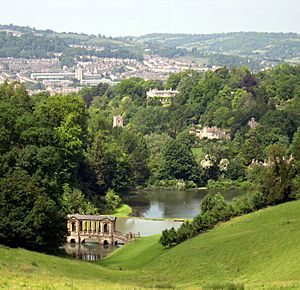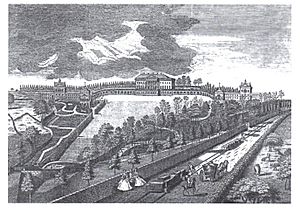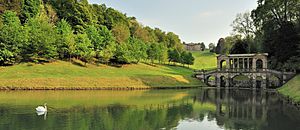Prior Park Landscape Garden facts for kids
Prior Park Landscape Garden is a beautiful historic garden located near Bath, Somerset, England. It was created in the 1700s by the famous poet Alexander Pope and the skilled garden designer Capability Brown. Today, the garden is cared for by the National Trust. This garden was very important in shaping the "English landscape garden" style, which became popular across Europe. It is recognized as a Grade I listed site, meaning it's a very special historic park.
Around the year 1100, this area was a deer park for the Bishop of Bath and Wells. In the 1720s, a man named Ralph Allen bought the land and designed the garden to go with his new house. Later, the house became a school, which is now Prior Park College. In the 1990s, the National Trust took over about 11.3 hectares (28 acres) of the park and started a big project to bring it back to its original beauty. The garden has many interesting features, including a special Palladian architecture bridge, a lake, and other old buildings.
Contents
History of Prior Park Garden
Prior Park is set in a small, steep valley that looks out over the city of Bath. Around 1100, the Bishop of Bath and Wells, John of Tours, created a deer park here. Over time, the land changed hands. It was owned by Humphrey Colles, a lawyer, and then by Matthew Colthurst. Before the monasteries were closed, the deer park walls fell apart, and the deer escaped. The land then became farmland.
Designing the Garden in the 1700s
In the 1720s, a local businessman named Ralph Allen bought the land. He was a kind person who gave a lot to his community. He started building his house and, at the same time, began creating the 11.3-hectare (28-acre) English landscape garden. He got advice from the poet Alexander Pope while the house was being built, from 1734 until Allen's death in 1764.
In 1737, more than 55,200 trees were planted, mostly elm and Scots pine. These trees were placed along the sides and top of the valley. The valley floor was kept as open grassland. Water from drainage was used to create fish ponds at the bottom of the valley.
Later, in the 1750s and 1760s, the famous garden designer Capability Brown worked on the gardens. He made the gardens bigger towards the north. He also removed a central waterfall and made the wooded hillside look like one smooth sweep. This garden was very important in creating the "English garden" style that spread across Europe. The gardens had two main parts. On the east side of the house, there were vegetable plots along a winding path. On the western side, there were statues, grottoes (small caves), trees, and climbing plants. Some exotic plants, like Aristolochiaceae and Passiflora, which were new to Britain, were also planted here.
In 1828, the house and estate were bought by Bishop Augustine Baines to start a seminary (a school for priests). Later, Bishop William Clifford used it for a Roman Catholic grammar school, which became Prior Park College. More changes were made to the landscape in the 1880s.
Bringing the Garden Back to Life
In 1993, the National Trust bought the park and pleasure grounds. They opened it to the public in 1996. In November 2002, a big project began to restore the waterfall, the winding lake, and a Gothic temple in a wilder part of the garden. This work is now finished. Many new plants were also added in 2007. Future plans include fixing the roof of the grotto and building a new Gothic temple.
Cool Features of Prior Park Garden
The garden has many interesting things to see. It includes a special Palladian architecture bridge, which is one of only four like it left in the world. There's also a Gothic temple, a gravel cabinet, Mrs. Allen's Grotto, and an ice house. You can also find a lodge and three pools with unique "curtain walls," as well as a winding lake. The curtain wall by the lake is sometimes called the Sham Bridge. It looks similar to other famous garden features like Kent's Cascade at Chiswick House. Ralph Allen also built Sham Castle on a hill overlooking Bath.
At the main entrance, there are stone pillars with fancy tops and large decorative vases. The pillars at the drive entrance have carved ornaments. The Porter's Lodge, a small building near the entrance, was built at the same time as the main house.
The Palladian Bridge
The Palladian bridge is a copy of one found at Wilton House. It is considered a Grade I listed building and a scheduled monument, meaning it's very important and protected. It was repaired in 1936 to keep it safe.
The Bath Skyline Walk
Just a five-minute walk from Prior Park Garden, you can join the Bath Skyline trail. This is a six-mile (10 km) circular walk around the city. As you walk, you'll see woodlands, open fields, an old Iron Age hill-fort, and places where Romans once lived. You'll also spot 18th-century follies (buildings built just for decoration) and enjoy amazing views over the city of Bath.





